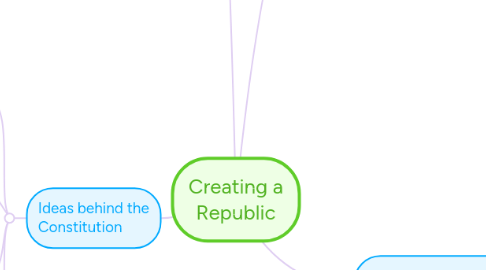
1. A Loose Confederation
1.1. States wrote the constitution
1.1.1. to list the rights of all citizens
1.1.1.1. to limit the power of a government
1.1.1.1.1. similar to a colonial government
1.2. The Articles of Confederation was a plan to run the nation as a whole
1.2.1. allowed for 13 branches of government
1.2.1.1. one vote per state
1.2.1.1.1. 13 states had to approve any changes
1.3. Strengths
1.3.1. declare war
1.3.1.1. appoint military officers
1.3.1.1.1. coin money
1.4. Weaknesses
1.4.1. didn't want to give up power
1.4.1.1. limited the power of the central gov.
1.4.1.1.1. feared a repeat of replacing tyranny
1.4.2. Congress's power was limited
1.4.2.1. no regulation of trade
1.4.2.2. no ability to tax
1.4.2.3. no one to ensure the Congress were being followed
1.4.2.4. no power to resolve wars between battles
1.4.2.5. easy for other countries to take over
1.5. Land Ordinance of 1785
1.5.1. system of settling the Northwest Territory
1.5.1.1. Present day states of Ohio, Indiana, Illinois, Michigan, and Wisconsin.
1.5.1.1.1. within each township, one section was set aside for public schools
1.5.2. Settling the lands west of the Appalachian Mountains
1.6. Northwest Ordinance of 1787
1.6.1. set up a government for the Northwest Territory
1.6.1.1. Gave basic rights to settlers
1.6.1.1.1. outlawed slavery
1.7. Growing Farms
1.7.1. Shay's Rebellion
1.7.1.1. states raised taxes
1.7.1.1.1. people couldn't pay for their loans and taxes.
1.7.2. Rebellion
1.7.2.1. in 1786
1.7.2.1.1. Daniel Shays= MA farmer
2. Ideas behind the Constitution
2.1. Rome's Republic
2.1.1. delegates wanted to create a republic
2.1.1.1. Roman citizens were willing to work in the public office (they were independent
2.2. Britain's Traditions of Freedom
2.2.1. What did the Magna Carta contain?
2.2.1.1. It made it clear that English monarchs themselves had to obey the law.
2.2.1.2. King John agreed not to raise taxes without first consulting the Great Council of nobles and church officials.
2.3. The American Experience
2.3.1. Virginia colonists set up the House of Burgesses
2.3.1.1. The Mayflower Compact was the first document of self government in North America.
2.3.1.1.1. all colonies had their own charters
2.4. Teaching's of the Enlightenment
2.4.1. a ruler must enforce the laws and protect the people
2.4.1.1. if a ruler violates the people's rights they have a right to rebel.
2.4.1.1.1. Baron de Montesquieu suggested that there should be 3 branches of gov.
3. The Constitutional Convention
3.1. 3 branches
3.1.1. Legislature
3.1.1.1. branch of government that passes laws.
3.1.2. Judicial
3.1.2.1. branch of government that decides if laws are carried out fairly.
3.1.3. Executive
3.1.3.1. branch of government that carries out laws.
3.2. Constitutional Convention
3.2.1. gathering of state representatives on May 25,1787 to revise the Articles of Confederation.
3.3. Important people
3.3.1. James Madison
3.3.1.1. best prepared delegate of Virginia, is called “Father of the Constitution”. He had ideas of how to structure a democratic government strongly influenced the other delegates.
3.3.2. Roger Sherman
3.3.2.1. from Connecticut, he worked out a compromise that he hoped would satisfy both the large and small states,
3.3.3. George Washington
4. Ratification and the Bill of Rights
4.1. Federalists debate Anti-federalists
4.1.1. Federalists
4.1.1.1. supporters of the Constitution
4.1.1.1.1. Federalists believed that the Constitution gave the national government the authority it needed to function effectively.
4.1.2. Anti-federalists
4.1.2.1. opposed the Constitution
4.1.2.1.1. Anti-federalists felt that the Constitution made the national government too strong and left the states too weak and thought that the President had too much power.
4.2. Key Issue:need for Bill of Rights
4.2.1. Bill of Rights protected basic liberties such as freedom of speech and religion.
4.2.1.1. George Mason wrote the Bill of Rights for Virginia's constitution
4.3. The states vote to ratify
4.3.1. The first key battleground was Massachusetts
4.3.1.1. Adams and Hancock recommended adding the Bill of Rights to the Constitution
4.4. Adding a Bill of Rights
4.4.1. In order for the Constitution to be ratified the Bill of Rights had to be added.
4.4.1.1. 3/5 of the states ratified 10 of the 12 amendments
4.4.1.1.1. John Adams says that the Bill of Rights takes away your natural rights and does not give any rights. He said that the rights listed, were the natural rights that belonged to everybody.

